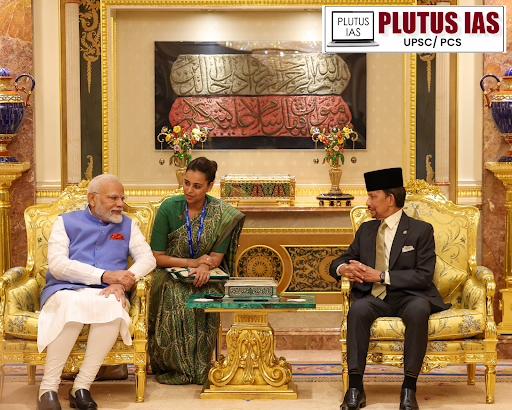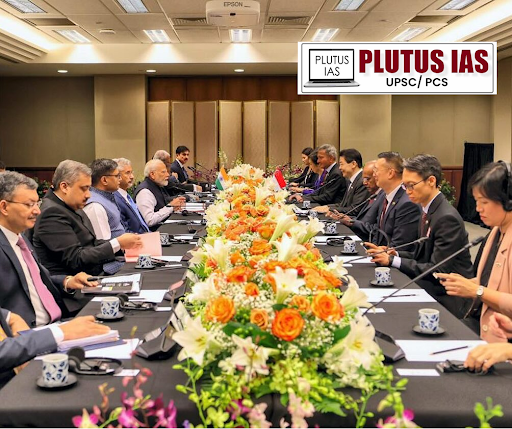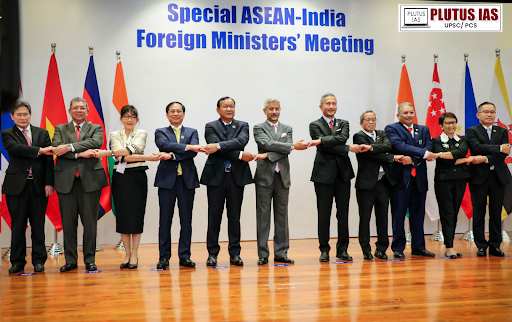09 Sep “India-ASEAN Partnership: Advancing Cooperation and Shared Futures
This article covers “Daily Current Affairs” and topic details of the “India-ASEAN Partnership: Advancing Cooperation and Shared Futures
Syllabus mapping:
GS-2: International Relations: India and its Act East Policy
For Prelims:
What is ASEAN? India- ASEAN relationship facts, RECEP, BIMSTEC, and Ganga Mekong Cooperation members.
For Mains:
How did the India Look East Policy transform into the Act East Policy? What are the major driving areas of the India- ASEAN relationship, Issues of divergence, and suggestions for future engagement?
Why in the News?
India’s Prime Minister recently made headlines with two landmark visits to ASEAN countries: Brunei and Singapore. His trip to Brunei was historic, marking the first visit by an Indian Prime Minister in over 40 years, reflecting a renewed commitment to strengthening ties with this key Southeast Asian nation. Meanwhile, the visit to Singapore heralded a new chapter in bilateral relations, elevating them to a Strategic Comprehensive Partnership.


INDIA- ASEAN RELATIONSHIP
Historical Context and Policy Evolution:
Look East Policy (1992):
Origins: Initiated by Prime Minister Narasimha Rao, focusing on strengthening ties with Southeast Asia. Later extended to East Asia and Oceania.
Act East Policy (2011-2014):
Revised Focus: Encouraged by U.S. Secretary of State Hillary Clinton to transition from “Look East” to “Act East.”
Adoption: Formalized by External Affairs Minister Sushma Swaraj and Prime Minister Narendra Modi, emphasizing proactive engagement in the Asia-Pacific region.
India – ASEAN Engagement:
Early Engagement: India became a Sectoral Dialogue Partner of ASEAN in 1992, a Full Dialogue Partner in 1996, and achieved Summit Partnership status in 2002.
East Asia Summit (2005): India became a founder member of the East Asia Summit, broadening its engagement with ASEAN and other regional powers.
ADMM Plus (2010): India joined the ASEAN Defense Ministers’ Meeting Plus, including key regional and global players.
BIMSTEC: India promotes sub-regional groups like BIMSTEC, encompassing Bangladesh, India, Myanmar, Sri Lanka, and Thailand, with Nepal and Bhutan joining later.
Ganga-Mekong Cooperation: Focuses on connectivity and cooperation with countries like Thailand, Cambodia, Laos, Vietnam, and Myanmar.

History of ASEAN:Formation (1967): ASEAN was founded by Indonesia, Malaysia, the Philippines, Singapore, and Thailand to foster regional peace and economic cooperation. Expansion: Brunei (1984), Vietnam (1995), Laos, Myanmar (1997) and Cambodia (1999). Forum Expansions: ASEAN Plus Three (1997): Expanded to include China, South Korea, and Japan. East Asia Summit (2005): Further expanded to include India, Australia, New Zealand, Russia, and the United States. ASEAN Charter (2008): Adopted on December 15, this Charter granted ASEAN a formal legal identity and enhanced its role in regional community-building. ADMM Plus (2010): India joined the ASEAN Defense Ministers’ Meeting Plus, including key regional and global players. |
Key Areas of Cooperation
1. Political and Security Cooperation: India actively participates in key regional forums such as the ASEAN Regional Forum (ARF), These engagements reinforce collaborative efforts on security issues and contribute to regional stability.
2. Economic Cooperation: ASEAN, India’s fourth-largest trading partner, saw trade rise from $65 billion in 2015-16 to $70 billion in 2016-17. The ASEAN-India Free Trade Area agreements, operational since July 2015, have significantly boosted trade and investment.
3. Socio-Cultural Cooperation: People-to-people initiatives, including Youth summits and cultural programs, further deepen socio-cultural ties between the regions.
4. Connectivity Projects: Infrastructure projects like the India-Myanmar-Thailand Trilateral Highway and the Kaladan Multimodal Project aim to enhance regional connectivity. The 2017 Connectivity Summit highlighted the importance of improving both physical and digital infrastructure.
5. Environment and climate change: The ASEAN-India S&T Development Fund and the ASEAN-India Green Fund provide vital resources for science, technology, and environmental initiatives.
6. Functional Areas: This includes establishing space tracking stations and upgrading facilities for space collaboration. Educational initiatives, such as the Centers of Excellence and the e-Network for telemedicine, underscore ongoing cooperation in research and development.
7. 1.5 Track diplomacy: The Delhi Dialogue is an annual Track 1.5 event that facilitates discussions on politico-security and economic issues between ASEAN and India.
8. Institutional Mechanism: Established in 2013, the ASEAN-India Centre (AIC) supports the implementation of connectivity initiatives and organizes events and workshops to foster deeper engagement between ASEAN and India.
Areas of Differences
1. Geopolitical Tensions: India’s strategic alliances and regional rivalries, particularly with China, can create friction with ASEAN countries that may have different geopolitical concerns or alignments.
2. Economic Imbalances: Discrepancies in trade balances and investment flows, such as India’s withdrawal from the RCEP, can strain economic relations and hinder deeper economic integration.
3. Different Human Rights Standards: Divergent approaches to human rights and democratic values between India and ASEAN countries can lead to diplomatic tensions, especially in multilateral forums.
4. Resource Management Conflicts: Differences in energy policies, such as India’s reliance on coal versus ASEAN’s shift toward renewables, can create conflicts in environmental and energy cooperation.
5. Climate goals: ASEAN pursuing immediate carbon reduction and India aiming for net zero by 2070, can complicate collaborative environmental efforts.
6. Digital Trade Barriers: India’s data localization laws and digital trade regulations may conflict with ASEAN countries’ tech operations, creating barriers to seamless digital trade and technology transfer.
7. Strategic Priorities Misalignment: India’s focus on Indo-Pacific security frameworks and alliances, like the Quad, can sometimes clash with ASEAN’s preference for a neutral, inclusive security approach.
8. Border security: The recent clashes in Manipur are mainly attributed to the supply of weapons from the groups in Myanmar, complicating the ASEAN engagement with India.
The future course of action to enhance the India- ASEAN relationship:
1. Enhance Geopolitical Coordination: Foster better alignment on geopolitical issues and navigate the complexities of regional security dynamics, especially concerning China.
2. Accelerate Connectivity Projects: Expedite infrastructure projects and connectivity initiatives to fully integrate Northeast India with Southeast Asia.
3. Promote Digital and Technological Partnerships: Leverage technological advancements and digital growth to enhance bilateral economic ties and innovation.
4. Strengthen Human Security Cooperation: Address human security challenges through collaborative efforts to manage cross-border crises and natural disasters.
5. Synergies in Indo-Pacific Visions: Emphasized the alignment of Indo-Pacific visions between India and ASEAN, with ASEAN as the focal point of the Quad’s vision.
6. Climate Change and Sustainability: Joint efforts in renewable energy, waste management, and disaster mitigation can address pressing climate challenges. Promote cooperation on the Mission LiFE (Lifestyle for Environment) initiative.
7. Reassess Trade Agreements: Revisit trade agreements like RCEP to address concerns and explore avenues for deeper economic integration.
8. Global South Issues: Advocate for collective action on issues faced by the Global South in multilateral forums.
9. Counter-Terrorism: Strengthen collective efforts against terrorism, terror financing, and cyber-disinformation.
10. Maritime Safety and Security: Focus on improving maritime safety, security, and domain awareness.
Conclusion
India’s historical connections with Southeast Asia and the evolution of its relationship with ASEAN reflect significant progress, but there is ample room for enhancement. By addressing existing challenges and capitalizing on opportunities for growth and cooperation, both India and ASEAN can unlock the full potential of their partnership. Continued engagement and proactive strategies will be essential in shaping a robust and dynamic future for India-ASEAN relations.
Download plutus ias current affairs eng med 9th Sep 2024
PRELIMS QUESTION:
Q. Consider the following countries:
1. India
2. Bangladesh
3. Nepal
4. Cambodia
5. Singapore
6. Thailand
7. Myanmar
How many of the given above countries are members of the Ganga Suvarnabhumi Programme (GSP)?
A. Only Two
B. Only Three
C. Only Four
D. Only five
ANSWER: C
MAINS QUESTION:
Analyze how India’s ‘Act East’ policy can be adapted to better align with ASEAN’s strategic interests and geopolitical concerns, particularly in the context of regional security dynamics and the influence of external powers like the US and China?
(250 words 15 marks)



No Comments